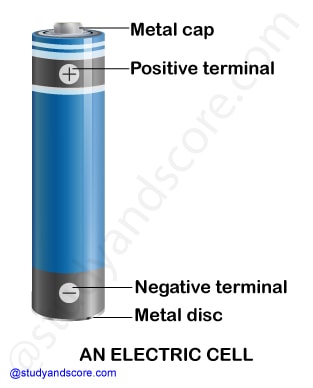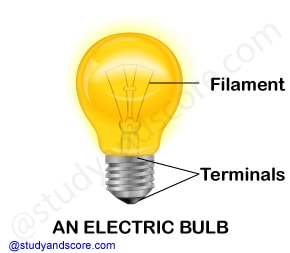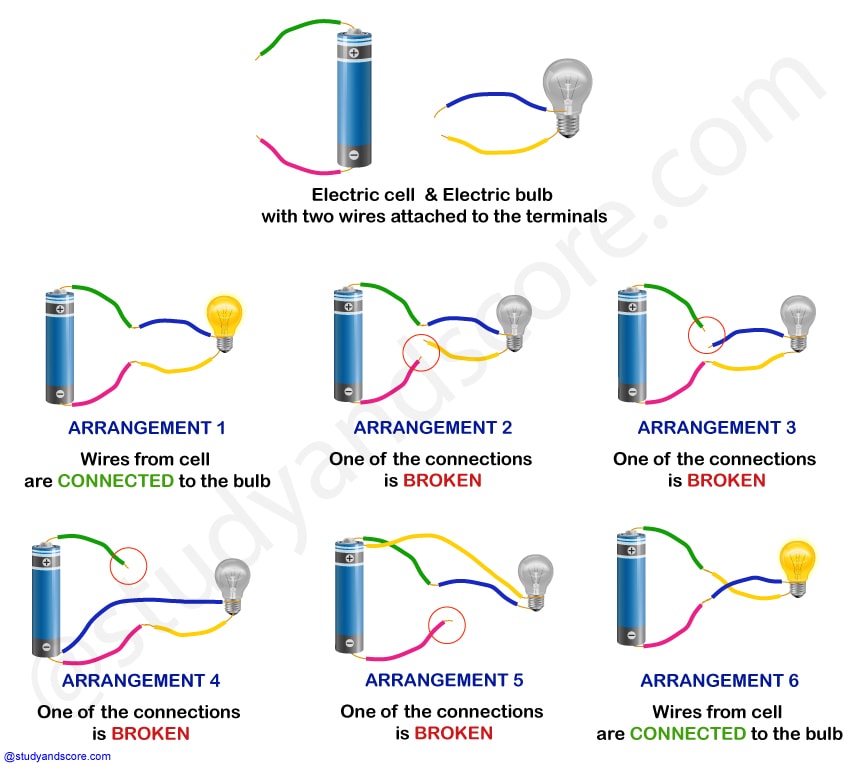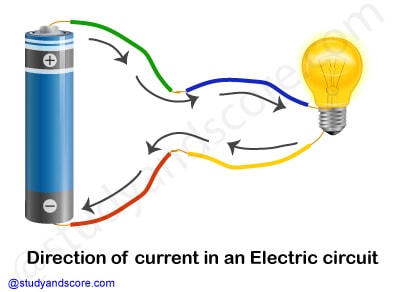Electricity makes our daily chores and tasks easy. We use electricity for many things. For example, we use electricity to operate pumps that lift water from wells or from ground level, we need electricity to turn on our lights or fans, we need electricity to light our street lights. Nowadays we also have motor vehicles which can be operated through electricity.
Electricity makes it possible to light our homes, roads, offices, markets and factories even after sunset. This helps us to continue working at night. A power station provides us with electricity. Sometimes the supply of electricity may fail or it may not be available at some places. In such situations, a torch is used for providing light. A torch has a bulb that lights up when it is switched on.
Electricity to the bulb in a torch is provided by the electric cell. Electric cells are also used in alarm clocks, wristwatches, transistor radios, cameras and many other devices.

An electric cell has a small metal cap on one side and a metal disc on the other side. Also all electric cells have a positive terminal and a negative terminal. Metal cap is the positive terminal and the metal disc is the negative terminal of the electric cell.
An electric cell produces electricity from the chemicals stored inside it. When the chemicals in the electric cell are used up, the electric cell stops producing electricity. The electric cell then has to be replaced with a new one.
|
The danger signs are displayed on poles, electric substations and many other places to warn people that electricity can be dangerous if not handled properly. Carelessness in handling electricity and electric devices can cause severe injuries and sometimes even death. Hence, you should never attempt to experiment with the electric wires and sockets. Also remember that the electricity generated by portable generators is equally dangerous. Use only electric cells for all activities related to electricity. |

The thin wire that gives off light is called the filament of the bulb. The filament is fixed to two thicker wires, which also provide support to it, one of these thick wires is connected to the metal case at the base of the bulb. The other thick wire is connected to the metal tip at the center of the base. The base of the bulb and the metal tip of the base are the two terminals of the bulb. These two terminals are fixed in such a way that they do not touch each other.
|
Caution: Never join the two terminals of the electric cell without connecting them through a switch and a device like a bulb. If you do so, the chemicals in the electric cell get used up very fast and the cell stops working. |
We can conduct the following experiment to know how a bulb connected to an electric cell glows. Take four lengths of electric wire with differently colored plastic coverings. Remove a little of the plastic covering from each length of wire at the ends to expose the metal wires. Fix the exposed parts of the wires to the cell and the bulb. Use electric tape/rubber band to stick wires to the bulb and to the cell.

Now, connect the wires fixed to the bulb with those attached to the cell in six different ways as shown above. For each arrangement, check if the electric bulb glows; we can observe that the electric bulb glows only in few arrangements. Compare the arrangements in which the bulbs glow or do not glow; and move the pencil along the wire all the way from one terminal of the cell to other terminal of the bulb.
After repeating this exercise for all the other arrangements we can conclude that the bulb only glows for the arrangements in which we can move the pencil from one terminal to the other. In other words the bulb glows only in the arrangements in which all the wires are connected properly. The bulb will not glow in broken connections.
In the previous experiment, the two terminals of the electric cell were connected to two terminals of the bulb (one terminal of the electric cell to the other terminal through wires passing to and from the electric bulb). Such an arrangement is a good example of an electric circuit.
The electric circuit provides a complete path for electricity to pass (current to flow) between the two terminals of the electric cell. The bulb glows only when current flows through the circuit. In an electric circuit, the direction of current is taken to be from the positive to the negative terminal of the electric cell. When the terminals of the bulb are connected with that of the electric cell by wires, the current passes through the filament of the bulb. This makes the bulb glow.

Sometimes an electric bulb does not glow even if it is connected to the cell. This may happen if the bulb has fused. An electric bulb may fuse due to many reasons. One reason for a bulb to fuse is a break in its filament. A break in the filament of an electric bulb means a break in the path of the current between the terminals of the electric cell. Therefore, a fused bulb does not light up as NO- current passes through its filament.
Electric switch is a simple device that is used to either open or close the electric circuits to turn on or turn off the electrical appliances. We can make a switch using two drawing pins; a safety pin, two wires and a small sheet of thermo col. Insert a drawing pin into the ring at one end of the safety pin and fix it on the thermo col sheet. Make sure that the safety pin can be rotated freely. Now, fix the other drawing pin on the thermo col sheet in a way that the free end of the safety pin can touch it. The safety pin fixed in this way would be your switch in this activity.
Now, make a circuit by connecting an electric cell and a bulb with this switch. We can observe that the bulb glows only when the free end of the safety pin touches other drawing pin and the bulb does not glow when safety pin is not in touch with the other drawing pin.
Safety pin covers the gap between drawing pins and in this position the switch is said to be 'on'. Since the material of the safety pin allows the current to pass through it, the circuit was complete. Hence, the bulb glows.
On the other hand, the bulb does not glow when the safety pin was not in touch with the other drawing pin. The circuit was not complete as there was a gap between the two drawing pins. In this position, the switch is said to be 'off'.
The switches used in lighting of electric bulbs and other devices in homes work on the same principle although their designs are a bit more complex.
Some materials allow the electricity to pass through them and some materials do not allow the electricity to pass through. Materials which allow electric current to pass through them are conductors of electricity whereas the materials which do not allow the electric current to pass through them are insulators.
Examples of conductors of electricity include copper, aluminum and other metals. Examples of insulators of electricity include paper, air, cotton thread, thermo col, plastic etc.
Conductors and insulators are equally important for us. Switches, electrical plugs and sockets are made of conductors. On the other hand, rubber and plastics are used for covering electrical wires, plug tops, switches and other parts of electrical appliances, which people might touch.
|
Caution: Your body is the conductor of electricity. Therefore, be careful when you handle an electric appliance. |
Link to Solutions on this topic
- Share with your friends! -
Login to post your comment here...
- or with social Account -